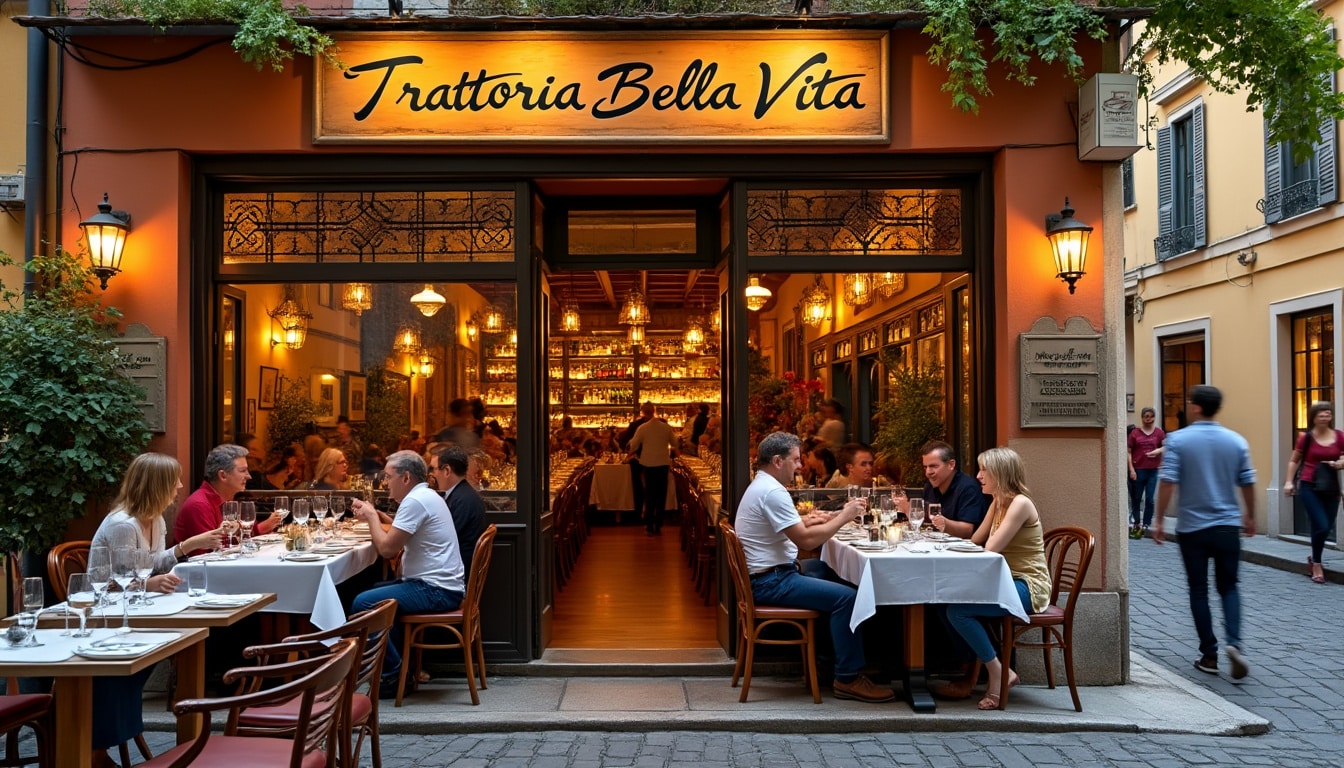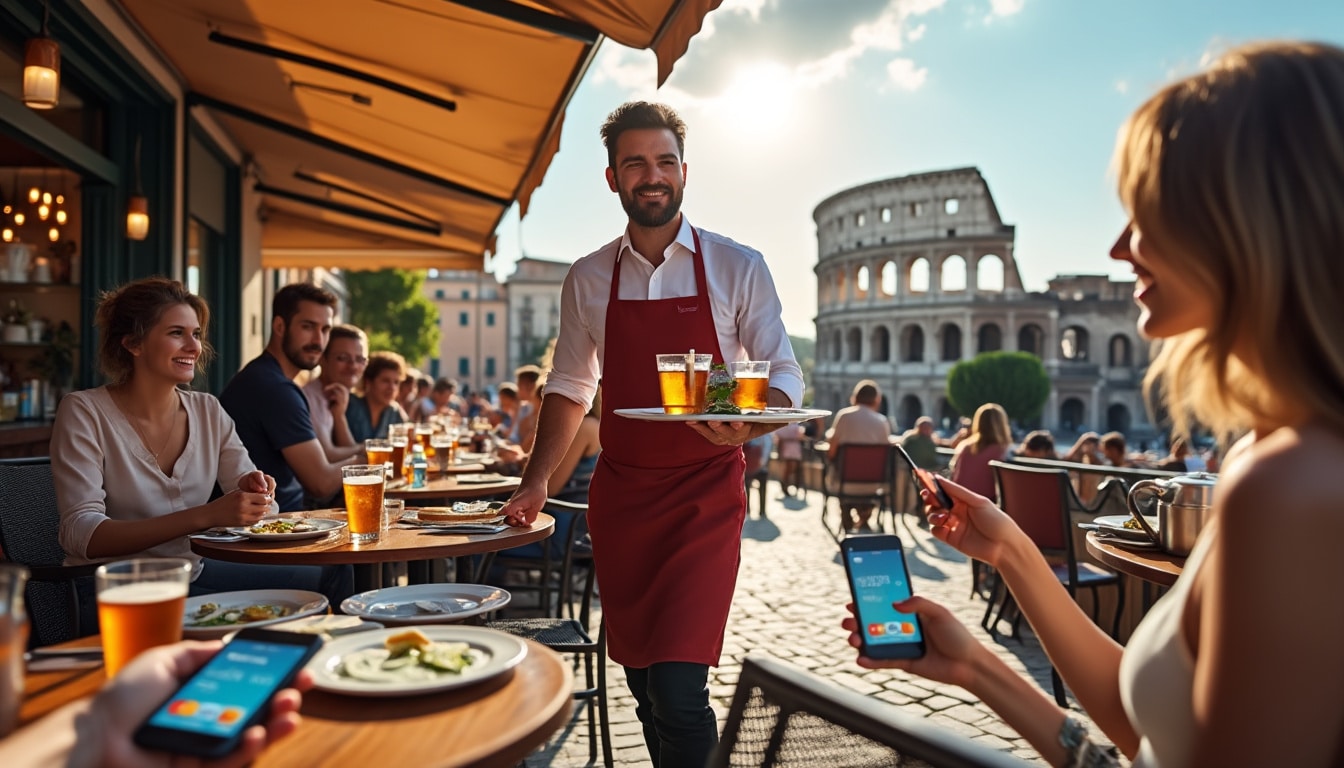When traveling to the Eternal City, understanding the intricacies of tipping and payment habits can enhance your experience and help you blend seamlessly with the local culture. Rome, with its rich tapestry of history, art, and cuisine, requires a unique approach to gratuity and payments, quite different from those in other parts of the world. Grasping the subtleties of these local practices will ensure your transactions are smooth, respectful, and well-received. So, prepare your RomeWallet and dive into the fascinating world of TipSmart in the heart of Italy, ensuring you’re a responsible and considerate traveler.
Tipping Etiquette in Roman Restaurants
Dining out in Rome provides an encounter with tastes that are as old as the city’s cobblestoned streets. However, it also presents the question of how to manage tipping, often leaving visitors curious about local expectations. The concept of CulturalTips in Roman dining is distinct and requires a nuanced understanding.
Unlike the United States, where service workers heavily rely on tips as a significant part of their earnings, in Rome, tipping is entirely voluntary. You might notice a service charge known as “coperto” on your bill, which covers bread and basic table service. This means an additional tip, though appreciated, is not necessarily expected unless the service has been exceptional. Generally, a tip rounding up the bill by small euros, such as leaving an extra euro on a €20 bill, is a kind gesture.
Restaurants’ Tipping Guide:
- 🍝 If a service charge is included, no additional tip is required.
- 🥖 A coperto often ranges from €1 to €3.
- 🥂 Exceptional service may deserve a small token of gratitude (€1-€2).
It’s worth noting that in some upscale dining establishments, a service charge might already constitute 10-15% of the total bill. Here, further tipping is redundant unless extraordinary service merits an extra token. Patrons should trust their discretion, using their cultural understanding as a guide. [Explore more on tipping in restaurants].

Local Tipping Behavior in Cafés and Bars
When in Rome, do as the Romans do, especially in their local cafés and bars. The LocalGiver approach here is laid-back yet courteous. At places where you stand at the counter to enjoy your espresso, tipping is not usually expected. However, in establishments where you are served at the table, a modest tip reflecting 5-10% of the bill shows your appreciation for the attentive service received.
Imagine sipping a cappuccino while observing the vibrant passersby. If your bill is €4.50, rounding it up to €5 is a small but appreciated gesture. More casual spots see patrons leaving behind spare change as a ‘grazie’ to the barista or server.
Tipping at Cafes and Bars:
- ☕ No tip required if serving oneself.
- 🍷 A small tip for table service (around €0.50-€1).
- 🎉 Round up for exceptional experiences or festive atmospheres.
The keyword here is moderation, asserting your acknowledgment without excess. This balance helps maintain a cultural exchange that is appreciated rather than expected. Should you have questions regarding what is appropriate, observing locals or simply asking kindly can illuminate the proper course. [Learn more about Rome’s payment customs].
Handling Tipping in Roman Hotels
When settling into your hotel in Rome, understanding the RomeGratuity etiquette can help you navigate the nuances of service recognition. Romans appreciate a subtle approach, where outward shows of gratuity are less significant than genuine expressions of satisfaction.
Bellhops and porters who assist with luggage greatly appreciate a tip of €1-€2 per bag. A simple “Grazie mille” can go a long way when expressing your gratitude for their hospitality. If you’re staying for several days, consider leaving a €1-€2 token each day for housekeeping, placed thoughtfully on the bedside table as a silent ‘thank you’.
Hotel Tipping Guidelines:
- 👜 Bellhops: €1-€2 per bag.
- 🛏️ Housekeeping: €1-€2 per day.
- 😄 No obligation if service is unsatisfactory or nonexistent.
Other services, such as concierge assistance, can warrant a tip if they go above and beyond in fulfilling unique requests or providing valuable local insights. [Discover tips on luggage storage services in the city].
Guides and Transportation: Tipping Guides in Tours and Taxis
Exploring Rome through guided tours offers another dimension to tipping. Here, RomeGratuity becomes an active gesture of appreciation. For half-day tours, a €5-€10 tip per person can demonstrate your satisfaction with a guide’s knowledge and capabilities, while full-day tours might see tips stretching from €10-€20.
When it comes to taxis or ride shares, the practice of rounding up fares is widespread. If your taxi fare is €13, consider rounding up to €15 as a simple, respectful gesture.
Tips for Tour Guides and Transport:
- 🚕 Taxi and rideshare: Round up the fare.
- 📚 Tour guides: €5-€10 for half-day tours.
- 🗺️ Full-day tours: €10-€20 depending on the experience.
Engaging with these services often allows brief yet impactful interactions with the city’s vivid tapestry. Drivers offering insightful tidbits about the city’s areas can further enhance your journey, making each short trip an immersion in Roman culture. [Learn more about taxi services in Rome].
Rome’s Payment Practices: Tech Meets Tradition
The evolution of CityPayments in Rome sits at the convergence between time-tested tradition and modern convenience. While cash remains a favored form of transaction—especially in smaller businesses—credit cards are widely accepted in restaurants, hotels, and more substantial shopping venues.
For international visitors, RomePay services simplify currency exchanges and make transactions smoother. It is common to carry both cash and cards to cover all bases. With the growing acceptance of contactless payments, having a credit card for convenience without excessive cash is a smart strategy to navigate Rome’s vibrant marketplace.
Payment Practices in Rome:
- 💶 Cash is king in smaller shops and markets.
- 💳 Cards accepted in major establishments.
- 📲 Embrace contactless for ease and speed.
Being adaptable with these payment approaches not only secures practicality but also shows reverence for the RomeGratuity culture, a reciprocal respect for tradition and convenience. [Read more about planning your transaction methods in Rome].
Additional Local Tipping Practices
Outside the commonly visited spaces, other places like spa retreats, salons, and event spaces like museums also reveal subtle nuances of the TippingGuide. In spas, tipping around 10% can express your gratitude for a rejuvenating experience. However, double-check whether a service charge has already been included in your bill to avoid over-tipping.
Museums or guided historical sites might warrant a small donation of €1-€2 as a token of thanks for their enlightening narratives.
Other Tipping Situations:
- 🛀 Spa services: 10% of service fee.
- 🏛️ Museums and sites: €1-€2 donation.
- 💈 Salons: Tips vary, check for service charges first.
These practices constitute a comprehensive RomeGratuity, ensuring visitors are well-prepared and courteous. As a city rooted in history yet vibrant in modern hospitality, the LocalTipping customs reflect the subtle art of demonstrating appreciation. Understanding these nuances elevates your visit from mere travel to an enriched journey of cultural insight.
FAQ: Tipping and Payment in Rome
- Do I always have to tip in Rome?
No, tipping is voluntary, though appreciated as a gesture of gratitude for excellent service. - What currency is accepted in Rome?
The Euro is the primary currency, with cash and cards both widely usable. - Is a service charge a tip?
Not exactly; it’s a cover for basic services, but doesn’t cover personal tips for exceptional service. - How can I tip in a foreign currency digitally?
Services like RomePay help manage digital tipping and straightforward transactions. - Are contactless payments common?
Yes, they are increasingly popular in Rome, especially in larger businesses.

